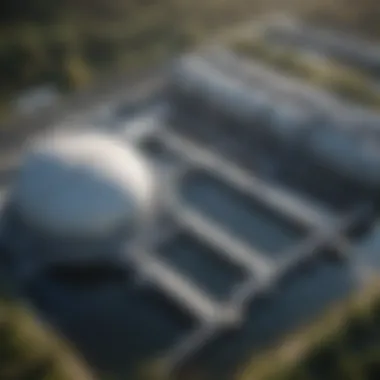Understanding Wastewater Biosolids: Production and Impact


Intro
Wastewater biosolids, often overlooked amongst more glamorous topics pertaining to environmental sustainability, deserve our undivided attention. With the rapid urbanization and the mounting population, proper management of human waste is more pressing than ever. You see, biosolids are not simply waste; they represent a unique resource that, when handled correctly, can contribute positively to our ecosystems and agricultural practices.
But what precisely are biosolids? Picture them as the dewatered and treated residuals from the wastewater treatment process. These materials undergo rigorous processing to eliminate pathogens and impurities, rendering them safe for reuse. In this comprehensive examination, we will peel back the layers of complexity surrounding wastewater biosolids, from their production and treatment to their regulation and applications. By doing so, we aim to shed light on their potential role in sustainable practices, transforming a potentially hazardous waste into a valuable resource.
Now, let’s dive into the key concepts concerning biosolids.
Preface to Wastewater Biosolids
Wastewater biosolids are an increasingly important topic in the field of environmental management and sustainability. These materials, derived from the treatment of sewage, hold a wealth of potential benefits when managed correctly. Not only do they represent a way to recycle nutrients back into the environment, but they can also aid in soil health, energy recovery, and resource conservation. Understanding the characteristics and composition of these biosolids is crucial, especially as we grapple with challenges like population growth and urbanization.
One might say that biosolids are nature’s forgotten treasure—rich in essential nutrients like nitrogen and phosphorus, which are critical for plant growth. If handled and utilized properly, they can reduce the need for synthetic fertilizers, contributing to more sustainable farming practices. Nevertheless, it's essential to note that biosolids come with their own set of complications, particularly regarding contaminants and public perception. Addressing these issues right from the start sets a strong foundation for the rest of our discussion.
Definition and Composition
Biosolids can essentially be defined as organic matter derived from municipal wastewater treatment processes. After sewage is treated and the liquid portion is separated, what's left behind is this nutrient-rich sludge. Its composition varies based on the source of wastewater and the treatment methods used, but generally, it comprises:
- Organic matter: This forms the bulk of biosolids and is crucial for soil structure and nutrients.
- Nutrients: Key elements like nitrogen, phosphorus, and trace minerals are present, providing the building blocks for plant growth.
- Pathogens and contaminants: While treatment processes aim to reduce harmful substances, some pathogens and heavy metals can still be present.
Understanding the typical composition of biosolids is vital for assessing their safety and potential applications in agriculture and land restoration.
Historical Context
The handling of human waste is hardly a new issue; it has roots that stretch back to ancient civilizations. Sumerians and Greeks recognized that utilizing decomposed organic matter could improve soil fertility, albeit in a rudimentary way. Fast forward to the 19th century, as urban growth forced cities to address waste disposal more systematically. The introduction of sewage treatment plants marked a significant turning point.
Over the decades, regulatory frameworks evolved significantly, largely influenced by environmental movements. In the United States, the Clean Water Act of 1972 established federal standards for wastewater treatment and biosolid management. This legislation made a clear distinction between beneficial uses of treated sludge and potential hazards, shaping how we view and handle biosolids today.
The integration of scientific research played a fundamental role in exploring the environmental and agricultural benefits of biosolids. With advancements in technology and a deeper understanding of microbial processes, the modern perspective on biosolids shifted towards viewing them as a valuable resource rather than just waste. This historical backdrop is essential for contextualizing the importance and relevance of wastewater biosolids in contemporary debates on sustainability and environmental protection.
Processes Involved in Wastewater Treatment
When we talk about wastewater treatment, it’s not just a matter of filtering out the yucky stuff. It’s a multi-layered process involving various techniques to ensure that the water we return to the environment is clean and safe. Understanding these processes is crucial, especially when dealing with biosolids, which are the by-products of wastewater treatment. These methods not only help in treating the wastewater but also play a significant role in producing biosolids that can be repurposed for beneficial uses.
The significance of these processes cannot be overstated because they address several pressing concerns: environmental integrity, public health, and sustainability. Efficient treatment processes reduce pollutants, safeguarding natural ecosystems. Furthermore, as we inch towards more sustainable practices, the treated effluents and biosolid derivatives create opportunities for resource recovery, thus making our approach to waste management more circular.
Physical Treatment Methods
Physical treatment methods are the initial steps in the wastewater treatment process, mainly focusing on removing suspended solids and debris. Various techniques, such as screening, sedimentation, and filtration, serve essential roles:
- Screening: This process employs physical barriers to intercept large particles, such as sticks or plastics, that might clog the system.
- Sedimentation: Once the larger debris is screened out, sedimentation comes into play. Wastewater is held in large basins, allowing gravity to pull heavier solids to the bottom, forming a sludge.
- Filtration: Filters then remove finer particles that escape the earlier treatments, ensuring that the water is clearer before moving to the next stage.
Understanding these methods provides a foundational perspective on how biosolids are generated from the solids removed during these physical processes. Without effective physical treatment, the entire cycle of wastewater management would be compromised.
Chemical Treatment Methods
Chemical treatment methods complement physical processes by utilizing chemicals to remove dissolved contaminants. Various attributes of this approach make it indispensable in wastewater management.
- Coagulation and Flocculation: In these processes, chemicals are added to cause pollutants to clump together, forming larger particles that can subsequently be removed more easily.
- Disinfection: Chemicals, such as chlorine or ozone, serve to kill pathogens present in the wastewater, making it safe for discharge or reuse.
- pH Adjustment: Sometimes, adjusting the pH is necessary to facilitate certain reactions that enhance the removal of specific contaminants.
These methods not only help in ensuring that the biosolids generated are treated but also enhance their quality for potential reuse in agricultural and landscaping applications.
Biological Treatment Methods
The biological treatment methods are where the magic happens. This process relies on microorganisms to break down organic matter in the wastewater. The advantages of biological treatment are numerous and include:
- Cost-Effectiveness: Utilizing natural organisms can often be less expensive compared to chemical treatments.
- Efficiency: Certain organisms are adept at breaking down organic constituents within wastewater, resulting in a significant reduction in pollution levels.


Several biological treatment methods are commonly employed:
- Activated Sludge Process: This involves aerating wastewater to promote the growth of microorganisms, which consume organic matter. The mixture is then settled to separate the treated water from the biomass.
- Biofilters: These systems allow water to pass through layers of biological media, where the microorganisms cling and digest any contaminants.
- Anaerobic Digestion: In this method, organic matter is broken down in the absence of oxygen. This process produces biogas, which can be harnessed as an energy source.
By appreciating the intricate ballet of these biological processes, we can better understand how they contribute to the creation of high-quality biosolids.
Efficient wastewater treatment processes not only reclaim water but transform waste into valuable resources.
Characteristics of Biosolids
Understanding the characteristics of biosolids is fundamental in comprehending their potential applications and the crucial role they play in environmental sustainability. Biosolids, which are the nutrient-rich organic materials resulting from the treatment of sewage sludge, have varying properties determined by their source and the treatment processes they’ve undergone. To paint a clearer picture, this section delves into two main aspects: nutrient content and pathogens and contaminants. Each of these elements sheds light on the usability of biosolids in agricultural and land restoration, as well as the necessary precautions in their handling and application.
Nutrient Content
The nutrient content of biosolids is one of its primary attributes that contribute to its potential as a soil amendment. Rich in essential macronutrients like nitrogen, phosphorus, and potassium, these materials provide an economical alternative to synthetic fertilizers, contributing to sustainable agricultural practices.
- Nitrogen, crucial for plant growth, is available in both organic and inorganic forms within biosolids, promoting vigorous vegetation and higher crop yields.
- Phosphorus supports root development and flowering, while potassium enhances overall plant health and resistance to diseases.
Moreover, biosolids also contain a variety of micronutrients such as zinc, copper, and manganese, necessary for the proper functioning of various plant enzymes. Utilizing biosolids not only reduces reliance on chemical fertilizers but also recycles nutrients from waste, aligning with ecological principles.
"Biosolids can serve as a multipurpose solution, improving soil properties while ensuring effective nutrient recycling in agricultural systems."
However, while enhancing soil fertility is an undeniable benefit, one must tread cautiously with the application. Potential nutrient overload can lead to environmental risks such as nutrient runoff into water bodies, contributing to issues like algal blooms and eutrophication. Therefore, the balanced application based on soil testing is vital to maximize benefits while minimizing ecological disturbances.
Pathogens and Contaminants
Addressing the presence of pathogens and contaminants in biosolids is equally paramount. While modern treatment processes significantly reduce the levels of these harmful organisms, risks still linger if not appropriately managed. Pathogens, including bacteria, viruses, and parasites, can pose health risks if biosolids are not adequately treated or applied incorrectly.
To mitigate these risks, biosolids undergo stringent treatment processes. The Class A biosolids, for example, are treated to levels low enough that they pose no significant risk of pathogens. Alternatively, Class B biosolids, while still usable, may require specific application restrictions to safeguard public health and safety. A few relevant points to consider include:
- Regulated Use: Class B biosolids are often restricted from being applied near areas such as public parks or schools until sufficient time has elapsed to allow for pathogen die-off.
- Monitoring Programs: Regular testing and monitoring are imperative to ensure that the biosolids produced meet safety standards and guidelines set by regulatory authorities.
Furthermore, contaminants such as heavy metals or organic pollutants must also be considered. The potential accumulation of these substances in soil and crops necessitates compliance with established limits to sustain environmental health and safety.
In summary, the characteristics of biosolids—particularly their nutrient content and possible pathogen presence—are complex but important elements to grasp. A nuanced understanding sets the groundwork for their beneficial applications while ensuring health and environmental standards are upheld.
Regulatory Framework
The regulatory framework surrounding wastewater biosolids plays a crucial role in ensuring that their treatment, handling, and application are conducted safely and sustainably. Proper regulations help mitigate the potential health risks posed by pathogens and contaminants found in biosolids, while also promoting their beneficial use in agriculture and land restoration. By clearly delineating the standards and protocols for biosolid management, regulations also protect environmental integrity and public interest.
National Regulations
National regulations form the backbone of biosolid management in many countries. In the United States, the Environmental Protection Agency (EPA) sets forth guidelines under the Clean Water Act specifically regarding biosolid use. This includes the 40 CFR Part 503, which outlines the conditions under which biosolids can be land applied, thus ensuring they meet certain quality criteria.
These regulations address several crucial aspects:
- Limitations on Contaminants: Detailed standards are provided for the maximum allowable concentrations of heavy metals, pathogens, and other harmful substances to protect public health.
- Testing and Monitoring Requirements: Facilities producing biosolids must conduct regular testing to comply with these established standards. This monitoring ensures ongoing safety and awareness of the contaminants present.
- Record-Keeping: Operators are required to maintain thorough records of biosolid treatment processes to maintain accountability and traceability.
Regulations like these are vital, as they not only dictate how biosolids should be processed but also define the penalties for non-compliance. Effective enforcement of these regulations helps to foster public confidence in biosolid recycling efforts.
International Guidelines
On an international level, various organizations provide guidelines aimed at harmonizing biosolid management practices across nations. The World Health Organization (WHO) offers frameworks that detail the safe use of biosolids in agricultural settings, addressing potential risks to human health and the environment. This is significant as it facilitates a shared understanding and implements best practices on a global scale.
Some points of note from these guidelines include:
- Sustainable Utilization: WHO's guidelines emphasize the importance of utilizing biosolids in a way that aligns with sustainable practices. This promotes the recycling of nutrients while safeguarding public health.
- Tailored Approaches: Different regions may require specific adaptations of these guidelines based on their unique environmental and health contexts. This flexibility allows for effective management tailored to local conditions.
- Common Standards: International guidelines contribute to establishing common standards, aiding countries in developing regulations that meet both regional and global objectives.
Compliance and Monitoring


Ensuring compliance with the established regulations is just as critical as the regulations themselves. Monitoring processes provide a system of checks and balances, guaranteeing that biosolid treatment facilities adhere to required standards. Regular inspections and audits can reveal potential lapses and rectify them before they escalate into larger issues.
- Independent Audits: Employing third-party auditors can enhance transparency and trust in the monitoring process. These entities assess compliance and provide unbiased feedback.
- Community Reporting Systems: Encouraging local communities to participate in reporting can lead to improved oversight. Such initiatives can empower citizens to engage with biosolid management more actively.
- Technological Innovations: Leveraging technology such as real-time monitoring and data analytics can streamline compliance processes. Advanced systems provide immediate insights into quality control and system efficacy.
Environmental Impacts of Biosolids
In the discourse surrounding wastewater biosolids, one cannot overlook the environmental impacts they entail. It's a subject of significant weight, as the benefits and challenges of biosolids influence not just agricultural practices but also broader ecological networks. From improving soil health to posing water quality risks, understanding these impacts is pivotal to advancing sustainable waste management practices. The discussion that follows aims to elucidate some of the essential aspects concerning soil health and water quality.
Soil Health and Fertility
Soil, often dubbed as the earth's crust, is more than just dirt; it is a living ecosystem. Incorporating biosolids into soils can be a game-changer. These products are rich in nutrients, notably nitrogen, phosphorus, and potassium, which are vital for plant growth and soil fertility. When biosolids are applied to land, they serve to enhance soil structure, improve aeration, and boost moisture retention. This is not some pie-in-the-sky theory but a reality, backed by agricultural practices that have successfully utilized biosolids over years.
- For instance, certain studies indicate that farms utilizing biosolids saw an increase in crop yields by up to 10% on average. Not a small feat, considering the consistent demands for increased food production as the global population swells.
"Biosolids can cleverly transform nutrient-deficient soils into productive land, proving beneficial for both agricultural communities and ecosystems."
However, there are caveats. The timing and methods of application need careful consideration. Over-application can lead to nutrient runoff, which may contribute to eutrophication in surrounding waters. Thus, while biosolids can enrich soil, they can also taint surrounding ecosystems if not managed wisely. Appropriate guidelines and regulations must dictate how biosolids are handled to maximize their benefits while mitigating possible downsides.
Water Quality Concerns
Water quality and biosolids have a complicated relationship. On one hand, these materials can help in preventing erosion, acting as a buffer in stormwater management. On the other hand, if not properly treated or if contaminated, biosolids can become a channel for pollutants, including pathogens, heavy metals, and organic contaminants.
- Pathogens included in improperly treated biosolids can present risks to human health and wildlife.
- Heavy metals such as lead or cadmium, total their way into the environment, potentially leaching into water supplies and threatening aquatic ecosystems.
It’s a balancing act, really; proper treatment technologies can effectively minimize these risks, ensuring that biosolids enhance rather than degrade water quality. Awareness among practitioners and the public about how biosolids can impact water systems is essential. This knowledge can lead to more informed decisions and management practices, ultimately promoting better water quality.
In summary, while biosolids present a myriad of environmental advantages, maintaining soil health and safeguarding water quality requires a nuanced understanding and responsible management. As the exploration of these impacts continues, there's an opportunity for broader discussions around environmental stewardship and resource management.
Beneficial Uses of Biosolids
Exploring the beneficial uses of biosolids reveals a multitude of potential applications that underscore their value beyond mere waste. Rather than being viewed solely as a byproduct of wastewater treatment, biosolids can be transformed into a resource that enhances soil health, supports land rehabilitation, and fosters renewable energy generation. This section delves into these applications, highlighting their significance in sustainable practices and environmental management.
Agricultural Applications
Biosolids have made a name for themselves in agriculture, where they serve as a nutrient-rich amendment for soil. Farmers are increasingly recognizing the benefits of incorporating biosolids into their farming practices.
- Nutrient Supply: Biosolids often contain essential nutrients like nitrogen and phosphorus, vital for plant growth. This presents a feasible option for soil enrichment, reducing dependence on chemical fertilizers.
- Soil Structure Improvement: The organic matter in biosolids enhances soil structure, promoting better aeration and moisture retention—two crucial factors for crop productivity.
- Cost-Effective Resource: By utilizing biosolids, farmers not only save money on fertilizer costs but also contribute to a circular economy, reducing waste in landfills.
Despite the advantages, some farmers may have reservations due to concerns about contaminants. It’s essential to ensure that the biosolids are treated adequately to minimize risks, making quality control a high priority in agricultural applications.
Land Restoration Projects
When it comes to restoring disturbed lands, biosolids are emerging as a key player. Their application in land restoration projects can revitalize degraded landscapes, such as former mining sites or landfills.
- Erosion Control: The application of biosolids helps stabilize soil, preventing erosion by providing a binding agent that promotes plant establishment.
- Promoting Biodiversity: Introducing biosolids onto barren land can enhance the microbial community, essential for plant growth. This improvement may lead to increased biodiversity over time.
- Cost-Effective Rehabilitation: Utilizing biosolids can provide a low-cost solution for governments and organizations looking to rehabilitate damaged ecosystems. Using a local resource not only benefits the environment but also supports local economies.
As always, care must be taken to monitor the levels of pathogens and contaminants in biosolids used for land restoration, ensuring that they meet regulatory standards.
Energy Recovery Opportunities
Biosolids also hold promise as a source of renewable energy. The generation of energy from biosolids is becoming an innovative field, promoting sustainability in waste management.
- Anaerobic Digestion: One of the most common methods of energy recovery involves anaerobic digestion, where microorganisms break down organic material in the absence of oxygen. This process generates biogas, which can be captured and used for electricity, heat, or as vehicle fuel.
- Heat Generation: The incineration of biosolids can be an efficient way to produce energy while simultaneously reducing the volume of waste that requires disposal.
- Resource Recovery: Through innovative technologies, energy recovery not only reduces landfill reliance but also creates a more sustainable cycle of waste management.
"Using biosolids for energy recovery exemplifies how we can transform waste into valuable resources, paving the way for a more sustainable future."
Challenges in Biosolid Management


The journey of managing wastewater biosolids is fraught with challenges that can complicate even the most committed environmental efforts. Understanding these obstacles not only highlights the multifaceted nature of biosolid management but also sheds light on the societal, logistical, and financial factors involved. To fully appreciate the relevance of this topic, one must consider how public perception, logistical hurdles, and financial limitations interact in ways that can either inhibit or propel the development of sustainable practices concerning biosolids.
Public Perception and Acceptance
Public perception plays a crucial role in the acceptance and implementation of biosolid management practices. Many people still associate biosolids with a negative connotation due to misconceptions stemming from their origins in sewage treatment. For instance, terms like "sewage sludge" can evoke images of health risks and unpleasant smells, even though treated biosolids are often safe for use in various applications. This perception can lead to community resistance, further complicating efforts to use biosolids in agriculture or landscaping.
The challenge lies in changing this narrative through education and transparency. When communities are informed about the rigorous treatment processes that biosolids undergo, which significantly reduce pathogens and contaminants, acceptance tends to rise. Additionally, positive case studies, where biosolids have been successfully utilized for improving soil health and fertility, can serve as poignant examples that shift public opinion. Thus, ongoing outreach and education remain pivotal in altering the public’s perception towards acceptance of biosolids.
Logistical Considerations
Logistical considerations encompass a multitude of factors ranging from transportation to application. Transporting biosolids from treatment facilities to disposal sites or agricultural lands can be a logistical headache. Given the often rural locations of farms and the urban centers from which biosolids are generated, the distance can add both cost and complexity to the process. Moreover, regulations can dictate specific methods of transportation and application, further complicating logistics.
Weather conditions can also pose a significant challenge. For instance, applying biosolids during excessively wet or dry periods can be detrimental to their effectiveness and create additional hurdles. Furthermore, local regulations that vary from place to place can add another layer of difficulty. Operators must remain attuned to a maze of policies designed to ensure the safe and effective use of biosolids, which can be daunting.
Financial Constraints
Financial constraints represent one of the most significant barriers to effective biosolid management. Despite the potential benefits that biosolids can offer, the upfront costs associated with treatment technologies and logistics can weigh heavily on already tight municipal budgets. For many cities, the costs to upgrade treatment facilities to deal with biosolids properly are substantial.
Rural communities, in particular, often struggle with limited budgets that can barely cover basic waste management, let alone the implementation of sophisticated biosolid treatment processes. This situation can lead to an under-utilization of biosolids, despite their potential to contribute positively to soil health and agricultural productivity.
From securing funding for research and development to navigating grant applications, financial considerations stretch across all levels of biosolid management. Sustainable practices may require up-front investments but promise long-term savings and environmental benefits, a balancing act that requires careful navigation.
"Effective biosolid management not only reduces waste but also creates a valuable resource for agriculture and land restoration. However, overcoming public perceptions, logistical hurdles, and financial constraints remains vital for success."
Future Perspectives
In the ongoing journey of wastewater management, the future perspectives of biosolid treatment and utilization hold a pivotal role. This significance rests on the intersection of innovation, research, and policy advancement that aligns with the pressing environmental issues we face today. As society grapples with the dual challenges of waste reduction and resource recovery, a closer examination of future prospects unravels pathways that may transform how we view and manage biosolids.
Innovations in Treatment Technologies
New technologies are at the forefront of changing how wastewater biosolids are processed. Advanced treatment methods show promise in enhancing the efficiency and effectiveness of biosolid processing. For instance, thermal hydrolysis is gaining traction. It not only reduces the volume of solids but also increases the biogas production potential when landfilled. Furthermore, microbial fuel cells could also signify a shift by using the organic material in biosolids to generate electricity, resulting in a win-win.
As technology evolves, the integration of automated systems and AI-driven analytics are expected to bolster operational efficiencies. Sensors that monitor biosolid characteristics in real-time can lead to more precise management, ensuring that any required adjustments in treatment processes are made promptly. This adaptability can significantly enhance biosolid quality, making them more viable for use in various applications.
"The application of cutting-edge treatments not only elevates the performance of biosolid management but also presents new avenues for sustainable practices that blend technology with environmental stewardship."
Research and Development
Ongoing research is crucial for uncovering novel approaches aimed at enhancing biosolid management. By probing deeper into biosolid composition and transformation processes, researchers can identify optimal strategies for their utilization. Areas of interest include exploring the bioavailability of nutrients in biosolids, which can improve their effectiveness as a soil amendment. Advances in genomic studies may also provide insights into the microbial community dynamics present in biosolids, informing methods to tailor treatment approaches accordingly.
Moreover, the development of pilot projects that test innovative applications can provide case studies that pave the way for broader acceptance of biosolid use in agriculture and land restoration projects. This emphasis on empirical research ensures that the benefits and potential risks associated with biosolid application are thoroughly analyzed and mitigated.
Policy Advancements
The landscape of biosolid management also relies heavily on evolving policies that encourage sustainable practices. Policymakers must navigate a complex terrain of public perception while crafting regulations that ensure environmental safety and promote beneficial uses of biosolids. Establishing clear guidelines and best practice frameworks can help dispel any lingering public concerns about the safety of biosolids.
Furthermore, fostering collaboration between governmental agencies, industry stakeholders, and research institutions can facilitate the exchange of knowledge and spur proactive strategies for biosolid management. Innovative policies that incentivize the adoption of advanced technologies or research initiatives can lead to increased funding opportunities and better infrastructures for biosolid processing.
Epilogue
In this article, the exploration of wastewater biosolids has shed light on the multifaceted nature of their management and utilization. Wastewater biosolids are a by-product of sewage treatment, and their significance cannot be overstated. They represent a critical element in the cycle of urban water management and contribute to sustainability efforts globally.
Recapitulation of Key Points
Throughout this examination, several central themes arose:
- Definition and Composition: The article began with a clear definition of biosolids, distinguishing them from raw sewage. Their composition, rich in nutrients, positions them as invaluable resource for enhancing soil health.
- Processes Involved in Treatment: A discussion on the physical, chemical, and biological methods reveals the complexities of the treatment process, ensuring that harmful pathogens are effectively eliminated.
- Regulatory Framework: Understanding the layers of regulation, both nationally and internationally, helps contextualize the safe management of biosolids.
- Environmental Impacts: The role of biosolids in enriching soil fertility vs. potential water quality concerns highlights the dual nature of this resource.
- Challenges and Perspectives: Addressing public perception and financial constraints is vital to improving acceptance and effective management.
These points collectively illustrate that biosolids are not merely waste, but rather a resource with potential positive impacts on agriculture and land restoration. The balance of benefits and risks must be carefully navigated for optimal outcomes.
Call for Continued Research
The landscape surrounding wastewater biosolids is continuously evolving, necessitating ongoing research to address pressing challenges and opportunities.
- Innovative Treatment Technologies: As new treatment methods are developed, they can potentially enhance biosolid safety and usability. Research plays a pivotal role in identifying and validating these advancements.
- Long-term Ecological Studies: Understanding the long-term impacts of biosolid application on ecosystems and human health requires robust studies. The intricate interactions between soil, water, and biosolids need exploration.
- Public Engagement: Future studies should also focus on improving public perception. Engaging communities in discussions around biosolid use can foster better understanding and acceptance.



